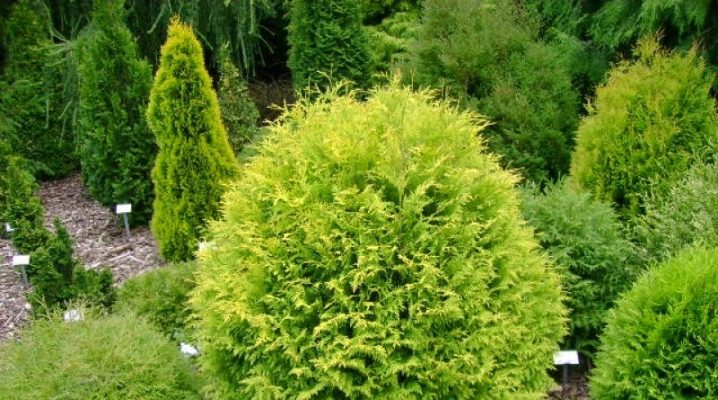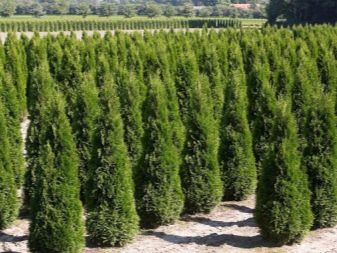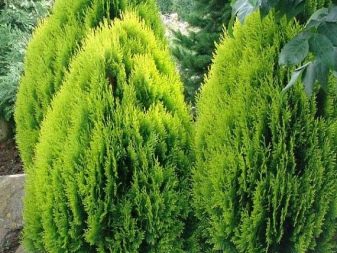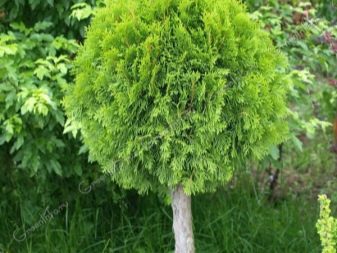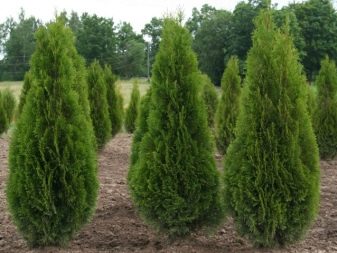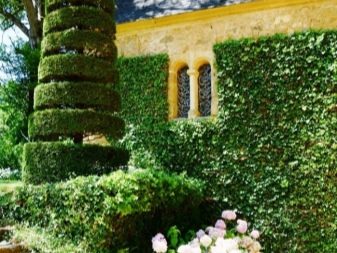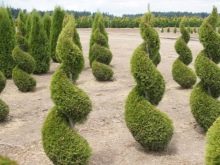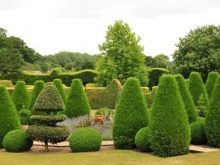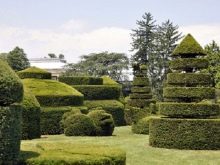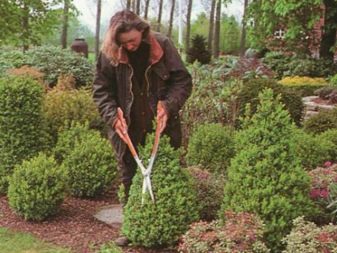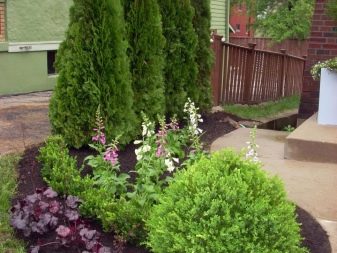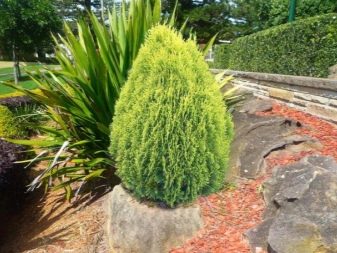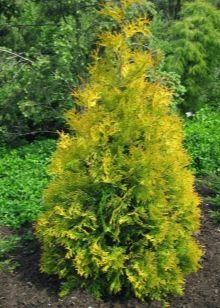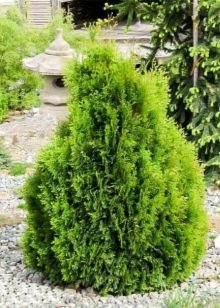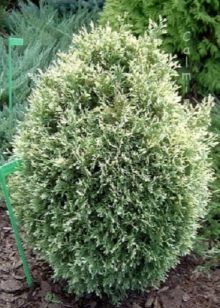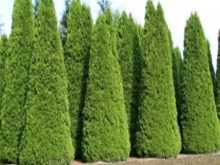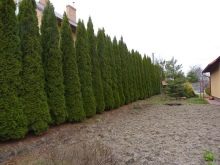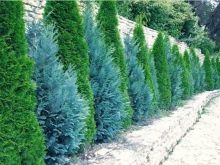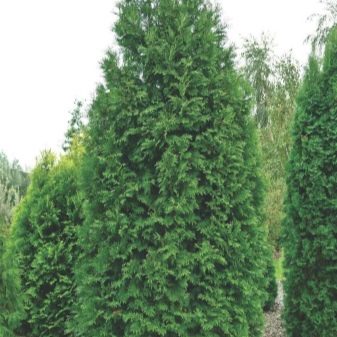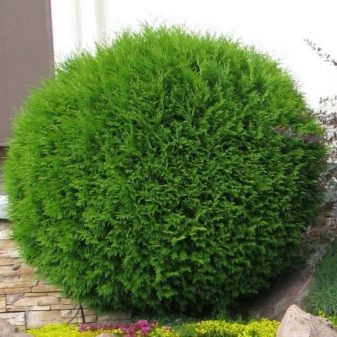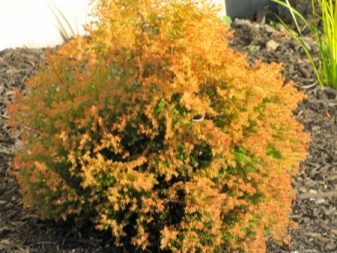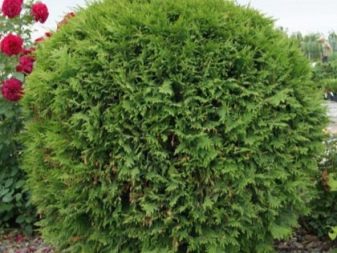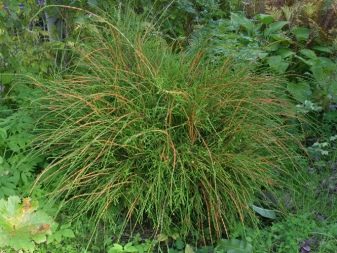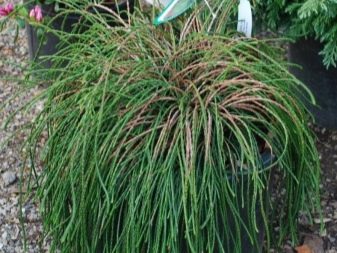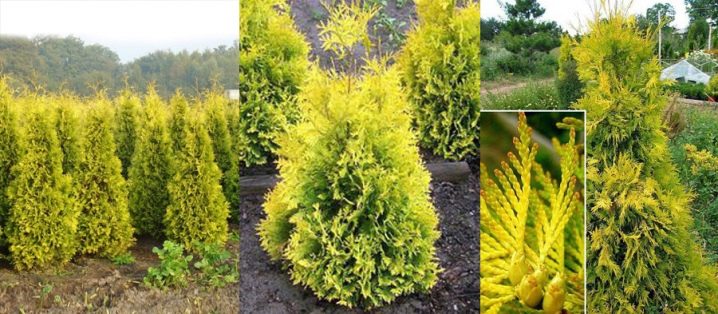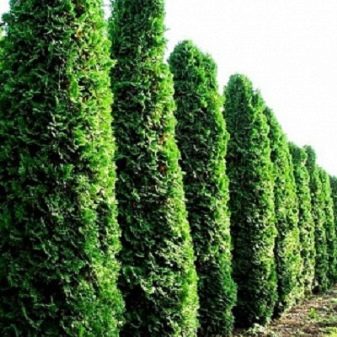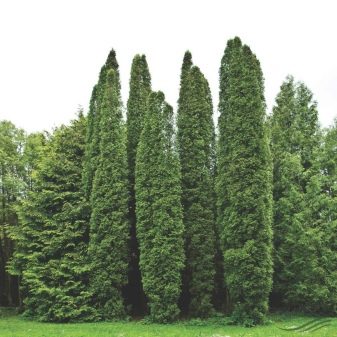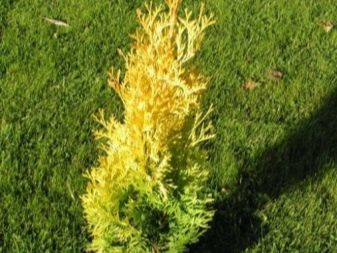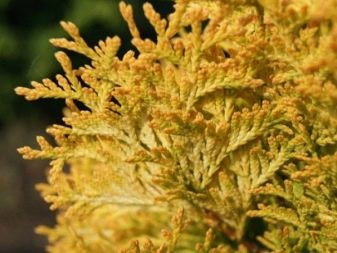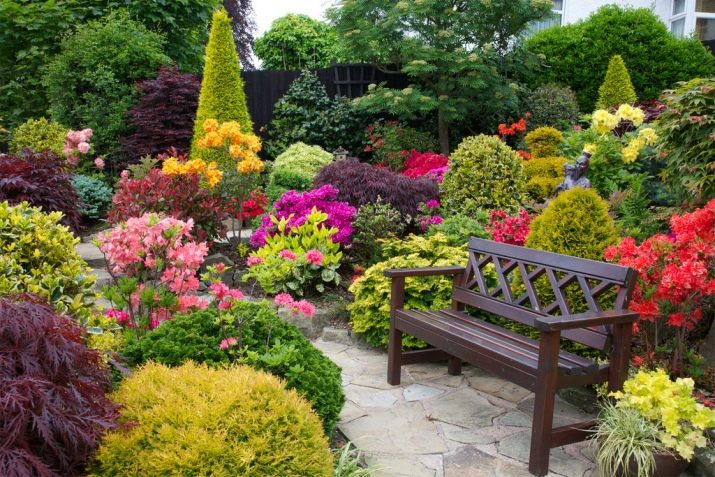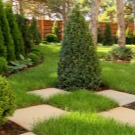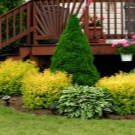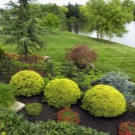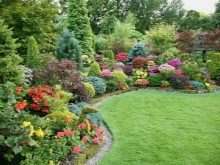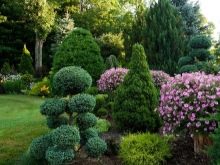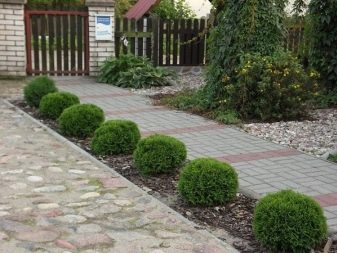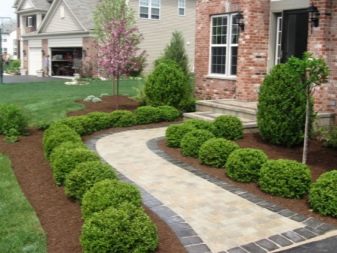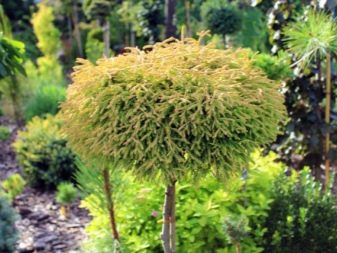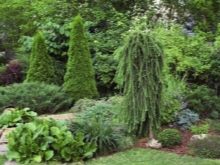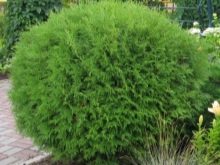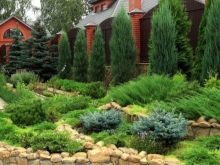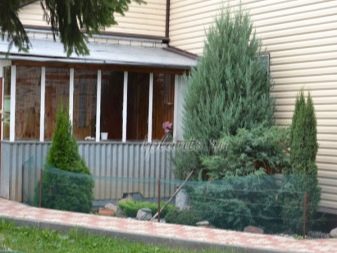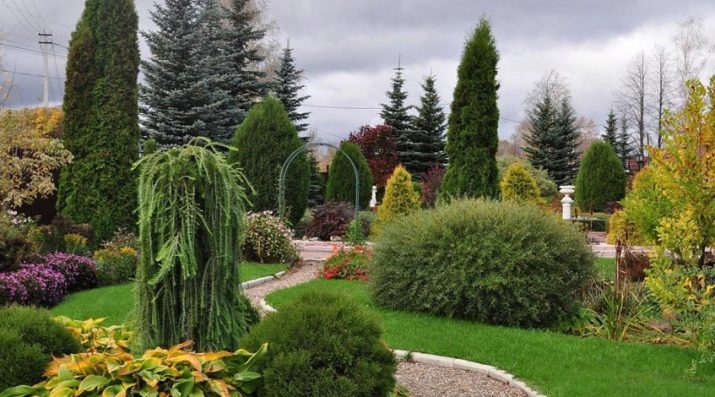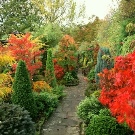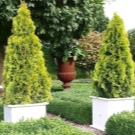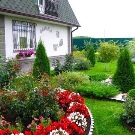Use thuya in landscape design
Today, thuja is becoming increasingly popular in the design of homestead territory. Tui have several dozen species and varieties: with different colors of needles, fast-growing and having a gain of only a few millimeters per year, spherical, conical and columnar crown. Let's get acquainted with this wonderful tree and its use in the design of land.
Features: pros and cons
In Russia, numerous groups of eastern and western thuja have proven themselves well. Their winter hardiness allows us to withstand frost seasons.
Some European varieties require shelter for the winter, but these types of thujs are very rare in our country, they are acquired by collectors and create appropriate conditions for them.On most sites planted thuja western.
Thuja western is more adapted to our climate, its homeland is Canada, where conditions are similar to the average in Russia. The thuja east is brought to us from Asia, it is more capricious, does not like the north wind, it is better to plant it on the windward side of the house.
Thuja can grow in partial shade and in the sun, do not require frequent watering. They get along well with other plants.
The green of the thuy is very dense, the needles are soft, the bark has a beautiful gray color. The color of the needles varies from yellow to dark green. The crown has the shape of a ball, a cone or a pyramid, the growth rate of some varieties is insignificant, they can maintain a constant accent in the composition for a long time, other varieties grow very quickly and need regular crown cutting.
The crown of such fast-growing tui can be given any shape. Several centuries ago, French and English gardeners began to create entire architectural parks of balls, columns, pyramids, cubes and other geometric figures from sheared thujs. Today, a whole trend has been developed in landscape design - topiarnoe art to create figures of animals, people, machines, famous art objects from soft needles.
The branches have a beautiful fan-shaped shape, sometimes twisted in a spiral.Thuja has a medicinal effect, its needles are emitted by phytoncides, which disinfect and purify the air, so it is useful to plant it near the house or a platform for rest.
Landscape designers of temperate climatic latitudes fell in love with all these qualities and external resemblance to the southern cypress. This coniferous plant is unpretentious and has a large variety of varieties, which allows you to include thuja in various landscape compositions or use soliter. Consider what types of these wonderful conifers can be used for decorative gardening of home gardens.
Types and varieties
Let us consider which varieties of the western thuja are cultivated in the temperate climate of central Russia.
- Aurea - with yellow needles, in the shade it acquires green shades that become darker in winter. It has thick needles, lends itself well to shaping, can be given any shape, because of its low growth (up to 2.5 meters) it can be used in compositions with conifers of other colors on the middle ground or with roses, hydrangeas, ferns - on the second. Due to its yellow color, it can be accentuated in the hedges of darker varieties.Looks beautiful with a purple hue barberry of Thunberg. This variety has branches originally arranged, which further enhances the decorative qualities. Annual growth of only 5 centimeters. This must be taken into account when purchasing a variety for your plot.
Young small specimens can be planted in flower beds with flowers, they will not compete for the area for a long time. If you want to create a large accent, you will have to wait a long time for the necessary decorative effect of this hodgepodge, so it is better to buy an adult large plant.
- Tuya Yellow Ribbon also has a yellow color of young needles, shave well, grows relatively slowly - 10 centimeters per year. Very winter hardy. Crohn narrow cone-shaped.
- Tuya Mickey It has similar characteristics, only the foliage is dark green and shiny.
- Albasic reaches a height of 2.5 meters, the needles are silver-colored wormwood with white tips, which creates an additional play of light. This effect looks very nice in hedges. The crown of albospikat is very wide and takes about a meter in diameter, which necessitates the need for additional space in the composition.It can be used as a separate ornamental tree.
- Emerald - the pyramid thuja most demanded in landscape design. It is distinguished by a rich green color, dense crown, which is finely cut, in winter it slightly darkens. Thuja tolerates a wide variety of conditions from full shade to bright sun, is not demanding for irrigation and is resistant to decay, excellent frost resistance make Smaragd indispensable for creating hedges. The height of an adult plant (about 3 meters) and a beautiful dense crown allow you to use this thuja to create park alleys.
It can also be used as a background for lower conifer and decorative flower arrangements.
- Has similar characteristics Thuja Brabantbut it is less winter-hardy and has a lighter crown, has a rapid growth (up to 50 centimeters per year).
- Globoza. The adult thuja does not need a hairstyle, has dense needles of bright green color of a spherical shape in height and up to 1 meter wide. Looks good in a single planting, and in combination with creeping junipers. Very loved by designers for the accuracy of the round shape.Often the main focus in flower arrangements.
- Tui Reinhold. She has an unusual golden-bronze needles, acquiring a pink tint in spring. It will be a great decoration rockery or flower beds. An adult plant has a height of 1 meter, quite winter-hardy.
- Tuya Danika, low - up to 0.7 meters, with a round, dense crown of rich green color. Very good in the alpine hills or in the street pots on the open terrace, in the form of a curb to the coniferous composition.
- Looks like her Thuja Woodwardy. It has a low compact round shape and contrasting color of foliage, from light to dark, which makes it decorative.
- Tuya Khozeri - dwarf variety, has a light green color of foliage, crown in the form of a ball, about 70 centimeters high. It is interesting to change the color of the needles throughout the year from light green to bronze.
- Filiformis. This thuja is completely different from the structure of the crown and branches to the previous specimens, rather a fountain. It harmonizes with creeping branches and can be used as a tapeworm.
- The same crown in the form of a fountain thuja folded - Wipcord. She has very slow growth, the maximum height is 1 meter.Adult tue give original standard shape.
- Tuya Sunkist It has a clear conical shape, it is characterized by very slow growth (up to 1.5-2 meters). The unusual color allows its use both in a single planting and in composition to create a yellow spot.
- Holmstrup - graceful columnar thuja, with dense beautiful noble silvery needles on twisted fan-shaped dense branches. Makes a great impression. It reaches a height of 4 meters. Used to form alleys and hedges.
- Tuya Columna - high, up to 10 meters in height, a coniferous plant of narrow columnar shape, with dense dark green needles. Growth for the year is 15-30 centimeters. Very unpretentious to the composition of air and soil. Long-liver.
- Amber - A new variety of tall thuja, height reaches 4 meters, it has a narrow conical crown. The value of the variety for the decor of the plot lies in the bright yellow needles, which requires a sunny location. Frost resistance is high.
Compatible with other plants
The many species and colors of this coniferous plant make it possible to make extensive use of thuja in landscape design.Thuy are perfectly combined with juniper of creeping forms. Spherical crowns and soft needles are beautifully combined with spruces.
Spiky and bright roses are an ornament of delicate greenery and spiral twigs of thujas. The same requirements for the composition of the soil with other conifers make them good neighbors.
How to choose?
Choosing a grade, it is worth reading about the cold resistance of one or another type. For this there are special correspondence tables. An important factor is the growth rate and height of the plant in adulthood. For an alpine slide, it is better to choose dwarf varieties with a minimum annual increase, but for hedgerows, large specimens with a quick regrowth of shoots are needed.
When choosing multi-colored options for hedges, you should focus on the same height of adult shrubs.
When buying seedlings in horticultural farms, it is necessary to assess the condition of the crown, its thickness and color. The presence of dried branches can suggest damage to the root system. Such a seedling will not restore the decorative form for a long time or it may even die.
Where to plant?
To plant a thuja, you need to choose a fairly sunny or semi-shaded place,no wind through. Soils should have a slightly increased acidity and be quite loose.
If the site is clayey, you need to dig a hole that is twice as large as an earthy lump, pour drainage from pebbles or expanded clay and make a soil mixture of sand, peat and soil. This mixture should feed the roots of the tree for many years, so that it shows all its decorativeness.
The ground water of the thuja is not terrible, it has a shallow root system. But wet lowland or marshy areas should be avoided.
After planting, it is recommended that the pristvolny circle be covered with a layer of coniferous bark.
Watering is necessary only in the first time for planting the seedling, it should be moderate. Landing is better to make in spring or summer. So the plant will be able to better take root and endure the winter.
Care rules
Frost-resistant varieties of winter cold are not terrible. Young seedlings still need protection in the form of a thick layer of mulch and shelter with agrospan of the ground part of the plant. Over the years, Tui will acquire the necessary resistance to low temperatures. Thermophilic oriental or European thuja planted in pots should be stored in a cool, bright room in winter.
The problem of all types of thujas is sunburn. In February and March, the bright sun dries soft needles, and the roots in a layer of frozen earth cannot deliver moisture to the foliage. The needles turn black and dry, it cannot be restored, these brown bald spots for several seasons will spoil the appearance of the tree. Burnt twigs are cut off in the spring and they are waiting for new shoots to grow, but the former density and uniformity of the crown can not be achieved. To avoid this, the crowns wrap a thin agrospan or gauze. The fabric must be breathable so that the seedling does not sprout.
In summer, thuis should be periodically watered from the crown with a hose, to arrange a shower for the needles.
It is necessary to regularly cut unevenly grown legs, which will stimulate more tillering. We'll have to clean the crown of dry twigs and cobwebs, so that the decorative effect of this coniferous plant is maintained throughout the time it is in the garden.
Beautiful design ideas
In the garden, you must find a place for the composition of these beautiful plants. There is a huge variety of options for the location of the Tui on the site. Coniferous bushes will decorate the ceremonial area.In the country you can equip rockeries with thujas, it will become the pride of the owners. The thuja hedgerow will close from prying eyes and create a noble natural barrier.
Tips on planting thuja, see the following video
